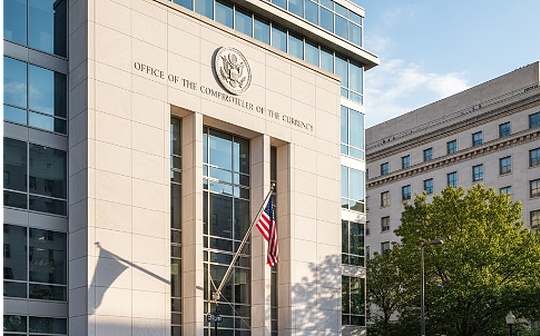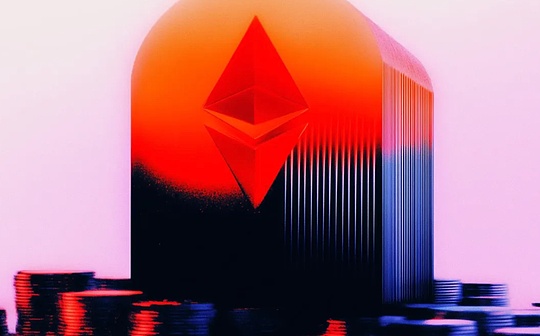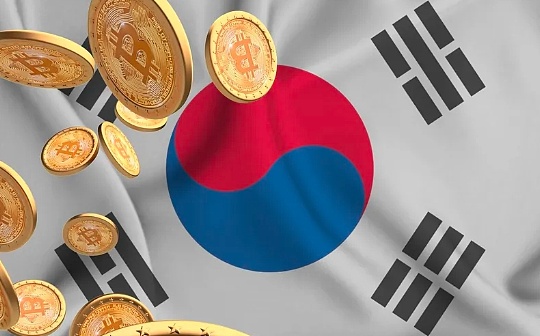
Source: Presto Research; Compilation: Tao Zhu, Bit Chain Vision Realm
summary
-
Driven by the masters of the technology, the cryptocurrency market in South Korea is characterized by dense retail investments, which has created unique phenomena such as “kimchi premium” and “listing boom”.
-
The history of Korean cryptocurrencies is marked by major regulatory development, mainly focusing on strengthening market integrity and investor protection.
-
However, despite the large transaction volume and the progress of supervision, the market builders still face challenges due to the public’s views on cryptocurrencies and the lack of supervision in the field.
Figure 1: Han Yu has always been the top two currencies in the global legal currency transaction volume.
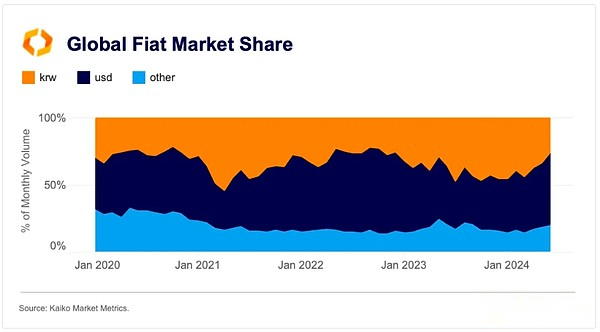
Foreword
Thanks to the extensive population of Internet access and proficient technology, South Korea has become a powerful country and plays an important role in the global cryptocurrency field.With its enthusiastic retail investor groups, South Korea shows unique market phenomena, such as “kimchi premiums” and “listing boom”, reflecting South Korean citizens’ enthusiasm for cryptocurrency investment.However, these actions have also aroused concerns from regulatory agencies and market observer, leading to new regulations, which are expected to affect the global cryptocurrency market.
In this research article, we (1) introduced the history of Korean cryptocurrencies, (2) the status quo of the industry, especially the above phenomena and new regulations, and (3) to explore some major participants in the domestic marketEssence
The history of cryptocurrencies in South Korea
~ 2017:
-
Before 2017, cryptocurrencies were not mainstream in South Korea, which is consistent with the global trend.Some noticeable events include KORBIT in 2013 to become the first cryptocurrency exchange in South Korea, followed by BITHUMB in 2014.
2017:
-
Bull market:2017 marks the beginning of South Korea’s enthusiasm for cryptocurrencies.The bull market has attracted millions of retail investors. Bithumb often ranks among the exchanges of the global daily transaction volume, and kimchi premium (later introduced) reached 30-40%.
-
ICO ban:In September 2017, the South Korean Financial Services Commission (FSC) announced the prohibition of the first token issuance (ICO) for all forms to protect investors and prevent potential financial fraud and speculative activities.So far, platforms such as CoinList are still banned in South Korea.
2018:
-
“Pu Xiangji crisis”:In January 2018, the Minister of Legal Affairs Park Xiangji announced that the government was considering closing all cryptocurrency exchanges, which caused a sharp turbulence in the market, and the price of Bitcoin fell sharply.
Figure 2: After he commented, the price of $ BTC fell sharply.
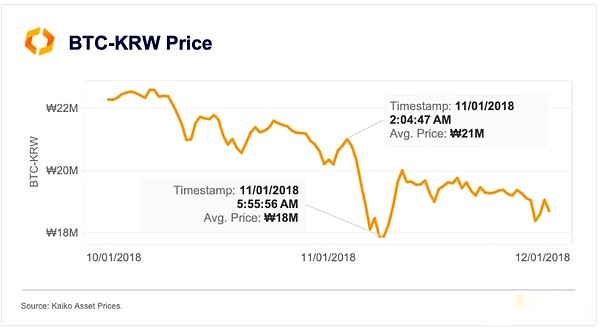
-
Real -name trading:On January 30, 2018, the “real -name system” began to be implemented, requiring all cryptocurrency exchanges to cooperate with banks to provide real -name authentication accounts for transactions, which aims to increase transparency and prevent money laundering.
2020/2021:
-
Amendment to the Special Financial Information Law:In March 2020, Congress passed the “Specific Financial Trading Information Report and Use Law” (usually called the Special Financial Information Law or 특금법) amendment to include the supervision of the cryptocurrency exchanges into it.The amendment requires all virtual asset service providers (VASP) to register with the Financial Services (FSC) and abide by the anti -money laundering (AML) and understand your customer (KYC) regulations.The law took effect in March 2021.
-
After this law was promulgated, only 29 of the 63 exchanges were successfully registered.Among them, only five of the exchange, Bithumb, Coinone, Korbit, and later GOPAX) have obtained ISMS certification and real -name accounts, and only they can operate the won of the won.
-
This law is also applicable to foreign exchanges, forcing Binance and other exchanges to close Korean support and P2P services.Up to now, three principles are applicable: do not support Korean won, use Korean, and prohibit direct Korean sales.
2022:
-
Terra Luna collapse:In May 2022, the collapse of Terra (LUNA) and its stablecoine $ USS caused a major turbulence in the global cryptocurrency market.This incident has had a significant impact on the psychology of the overall market, especially South Korean investors.It also aroused concerns about the stability of stablecoins and supervision and supervision.In view of the close connection between Terra and South Korea, especially through Do Kwon and its ecosystems, the incident had a significant impact on South Korea’s cryptocurrency pattern.
Figure 3: The recession of the Terra ecosystem.
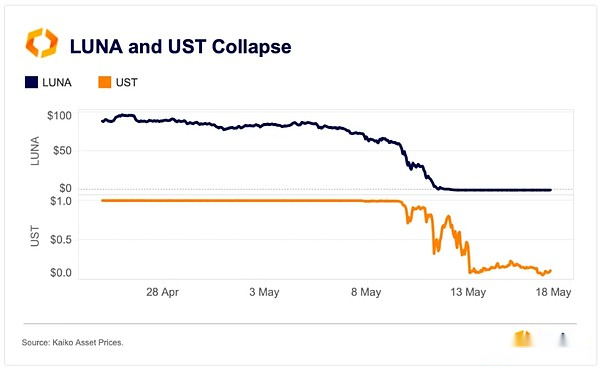
-
DAXA:The Digital Asset Exchange Alliance (DAXA) consists of the South Korea’s main exchanges (UPBIT, BITHUMB, Coinone, Korbit, and GOPAX), which aims to strengthen cooperation and establish industry standards to better protect investors and market integrity.
-
Travel rules:According to FATF guidance, South Korea launched the “Travel Rules” to improve the transparency of cryptocurrency transactions and crack down on illegal activities.
2023/2024:
-
Haru Invest/Delio bankruptcy:In 2023, two cryptocurrency digital asset management companies went bankrupt for suspected Ponzi scams.This incident exacerbated the negative emotions after LUNA collapsed. In the context of poor management and financial violations, it highlighted supervision vulnerabilities and investor protection.
-
Securities token issuance (STO) Guide:In February 2023, the Financial Services Commission announced the guidelines for regulating securities tokens in accordance with the Capital Market Law.This refers to southern section focusing on whether the tokens meet the principle of securities qualifications and regulations on the issuance and distribution of token securities.
-
Virtual asset user protection law:The bill was passed in June 2023 to protect investors by imposing fines for price control and other market abuse.This is the first phase of a comprehensive bill aimed at providing a comprehensive regulatory framework for digital assets.
2024+:
-
Virtual asset user protection law:The above bills will be implemented on July 19, 2024.Although the focus of this stage is to protect and prevent the abuse of transactions, the second stage is likely to focus on the market entry and operation of virtual asset service providers.However, the discussion in the second stage has not even begun. It takes 20 months to pass the first stage to pass it. It may take longer to see what content and timetable will be seen.
-
Cryptocurrency tax:Korean cryptocurrency duty has always been a key issue for the election season.Since 2022, the implementation of cryptocurrency duty has been repeatedly postponed, which is part of the government’s efforts to attract voters before the election.As of today, starting from 2025, the annual income of more than 2.5 million won (about 1,900 US dollars) will be levied a unified 20% capital benefit tax.
Figure 4: cryptocurrency duty of various countries.
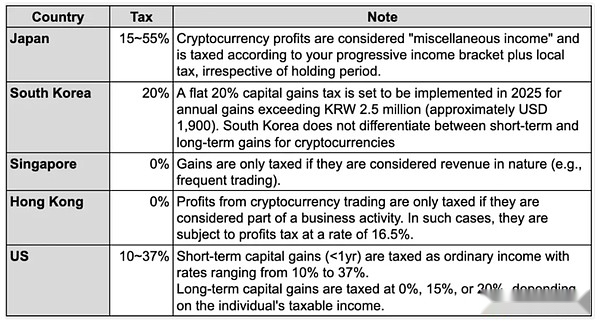
Virtual Asset User Protection Law
Since listing on the Korean Exchange has become an important milestone in the encryption project, people have a strong interest in the rules and regulations that manage the listing process.At present, the South Korean exchange has no clear regulations on the listing and delisting of cryptocurrencies.The only existing standard comes from the alliance DAXA consisting of five major Korean exchanges. The alliance provided a preliminary framework for the new listing in March 2023.However, the criterion was criticized for lack of clarity, so Daxa was amending the guidelines under the supervision of the regulatory agency to further refine it.This will be implemented in accordance with the “Virtual Asset User Protection Law”, which is expected to become a major progress in South Korea’s supervision, and everyone should pay attention to it.
Virtual Asset User Protection Law (虚)
The Virtual Asset User Protection Law is scheduled to take effect on July 19, 2024. It focuses on investor activities on the exchange, including: including:
-
Protect customer deposit
-
Strengthen the responsibility of custody
-
Surveillance suspicious transactions
-
insider trading
Guidelines for listing/delisting
Under the supervision of FSC/FSS, DAXA plans to implement the “Best Practice of the” Following the “Virtual Asset User Protection Law” after implementing the “Virtual Asset User Protection Law”.The guide includes listing and delisting standards, and is currently accepting industry feedback.The listing criteria include nine requirements, once every quarter of review, involving four main areas:
-
Publisher reputation
-
Non -disclosed major information related to virtual assets, or repeatedly changed arbitrarily without justified reasons.
-
Until the main wallet information of the issuer and operators.
-
User protection measure
-
Failure to verify important description materials (white paper) related to virtual assets prepared by the issuer and operator.
-
Lack of Blockexplorer.
-
Technical safety
-
Virtual assets, wallets, or distributed ledger occurring security incidents that cannot be explained or solved.
-
The source code of the inherent tokens of the distributed ledger has not been verified, and the important event function is not set up properly.
-
Abide by the regulations
-
The self -issued currency and other virtual assets that are regarded as illegal.
-
Support virtual asset transactions that may be used for illegal activities or violated existing regulations.
All virtual assets related to the above eight items are deemed to be unsatisfactory, so it should not be listed.In addition, the financial authorities also introduced the ninth qualitative review standard, including the following:
-
The ability to distribute, operate, and develop related subjects, social reputation, and past business history.
-
Disclosure of major information related to virtual assets.
-
Total distribution, changes in business plans, transparency and reasons for changes.
-
The access control settings of important functions related to token smart contracts are appropriate.
These continuous development guidelines are designed to provide a structured and secure environment for South Korean cryptocurrency transactions, solve the current fuzzyness and enhance market integrity.
So where are we now?
Retail fanaticism
Korean retail investor enthusiasm can be attributed to cultural factors. For example, due to the fast of the Internet, technology, adventure culture, and a single ethnic society that has developed rapidly and develop rapidly.Therefore, since 2017, South Korea has been one of the largest markets in the cryptocurrency field, and its exchanges have become a key platform for the project to win the listing.Even today, UPBIT has always ranked among the top five exchanges in the average transaction volume, and is usually second only to Binance.Considering that the Korean exchange is limited to South Korean residents, this is particularly surprising, unlike the wider exchanges such as Binance, Coinbase, and HTX.
Figure 5: UPBIT ranks second in the average transaction volume.
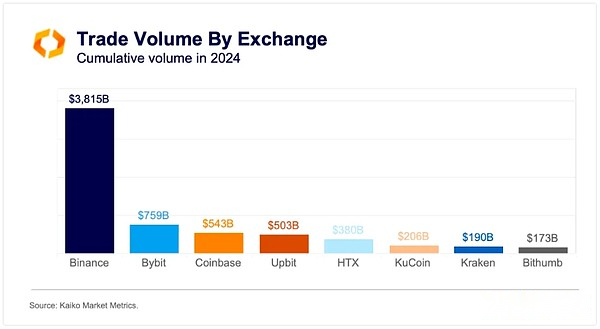
Recently, the volume of cryptocurrencies in South Korea has exceeded the transaction volume of KOSDAQ and KOSPI.The surge in transaction volume highlights the deep integration of cryptocurrencies in the country’s financial pattern.People’s strong interest in cryptocurrencies has led to some interesting market phenomena: kimchi premium and listing boom.
Kimchi premium
Kimchi premium refers to the difference in the price difference between the cryptocurrencies of the Korean exchanges and the global exchanges.Because regulatory challenges have hindered arbitrage, 2-3% of premiums are usually existing, which means that the price of cryptocurrencies in the Korean exchange is higher.However, during the market that specialized in a particularly bullish market in April, this premium may soar, reaching about 14%.
Figure 6: During the bull market with a large transaction volume, kimchi premiums soared.
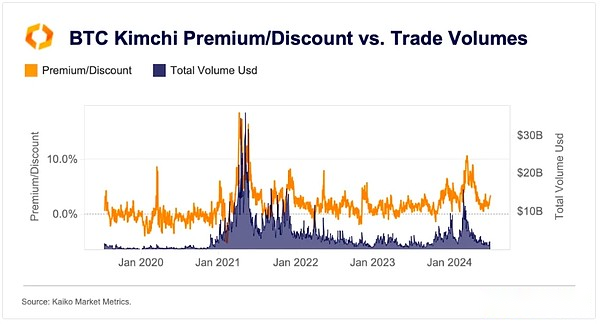
Listing pump
Another interesting phenomenon is that the listing is skyrocketing, and this happens when the UPBIT or Bithumb announces that a project will happen.According to factors such as market value, liquidity, and perpetual contracts, the price of newly listed cryptocurrencies will rise immediately after the announcement is announced.Although listing on the Korean exchange can indeed enhance liquidity and is usually regarded as fundamental favorable, so the surge in price is usually short -lived, often a disposable event, not a sustainable trend.
Figure 7: After UPBIT issued a listing announcement, the asset price rose.

Although it has made progress in regulatory exchanges and protection investors, the prospects of South Korean Web3 operations and builders have formed a sharp contrast.At present, there are no important Korean local projects entering the top 100 market value. This is surprising to consider the popularity of the asset category.The main obstacle factors seem to be the public’s attitude towards cryptocurrencies and the uncertainty of supervision around the web3 project.
Although cryptocurrencies are very popular in South Korea, it is usually regarded as a gambling method, not long -term investment in Web3 technology.Unstable market behavior (for example, the price soared before and after the release of the tokens) has strengthened this view. Therefore, the focus of the market is still short -term speculative, not a long -term long -term fundamentals of the web 3 fundamentals.invest.In addition, the collapse of LUNA in May 2022 exacerbated the public’s negative emotions of cryptocurrencies, which led the media to strictly review all crypto projects operating in South Korea.In addition, despite the sincere enthusiasm of the Korean people, these projects have become the goal of politicians and brought challenges to the sustainable development of South Korea.
Figure 8: Korean prefers cottage coins rather than the main currency.
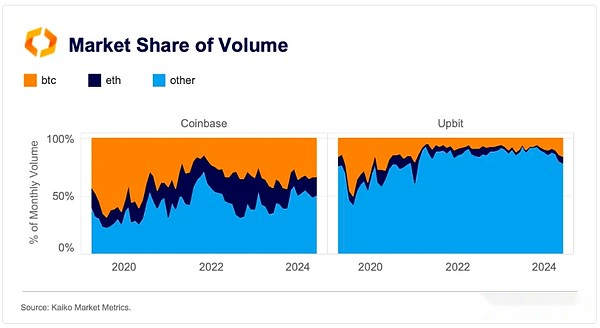
Unclear regulations have also exacerbated this complexity.Although government officials are actively formulating a regulatory framework, the current regulations mainly focus on investor protection, and rarely pay attention to supporting innovation and cultivation industries.For example, the virtual asset service provider (VASP) permit requires only exchanges, wallets and custodians, and the initial stage of the “Virtual Asset User Protection Law” mainly involves the operation of the exchange.In addition, South Korea’s ban on P2E games often leads to complex results. The world’s top Web2 game studios set up business in South Korea to contact local talents, but in the end they serve overseas markets.This fuzzy and delayed regulatory has forced many Korean developers to relocate its business to more favorable judicial jurisdictions such as Singapore. Although the country has technical capabilities, it still suppress local innovation.
The main participants of the Korean cryptocurrency market
Exchange
Although there is no clear regulatory regulation, due to the restrictions of the Financial Services Commission (FSC), South Korea is not allowed to conduct cryptocurrency futures transactions in principle.Therefore, the Korean cryptocurrency market is led by the five major spot exchanges: Upbit, BITHUMB, Coinone, Korbit, and GOPAX.These exchanges occupy a considerable market share, of which UPBIT and BITHUMB account for nearly 96%of the total transaction volume.
Figure 9: As of today’s Korean exchange market share.
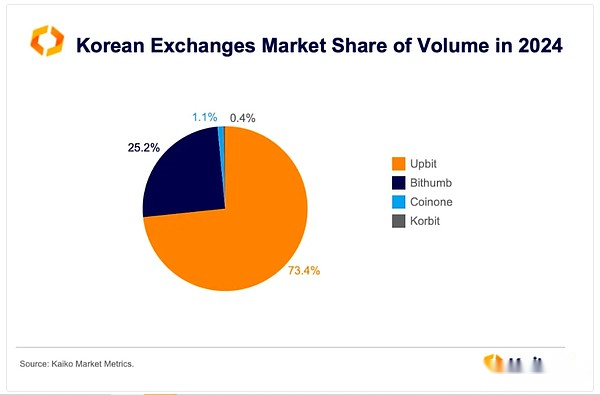
-
Upbit:Dunamu’s Upbit is undoubtedly South Korea’s number one cryptocurrency exchange.Dunamu also operates the stock trading platform Luniverse (Web3 products), and even the second -level monitoring platform and other businesses.Dunamu’s current valuation of the exterior trading market is about 2.5 billion US dollars, and the report said that sales in 2023 were $ 2.7 billion.Today, UPBIT provides KRW/BTC/USDT pairs, most of which transaction volume comes from the KRW market.
-
BITHUMB:Although the governance structure of Bithumb has been unclear, the exchanges currently have a valuation of about US $ 289 million in the off -site trading market, and it has been announced that IPOs are planned in 2025.Bithumb has always maintained the first place on the exchange market until 2020, but it has been taken away by UPBIT a lot of market share.Nevertheless, with a radical charging policy, Bithumb has recently re -obtained market share and continues to exert major influence, which is often proven in the “listing boom” of the exchange.
Figure 10: The history of market share of the Korean Exchange shows that Bithumb once occupied the first position until 2020.
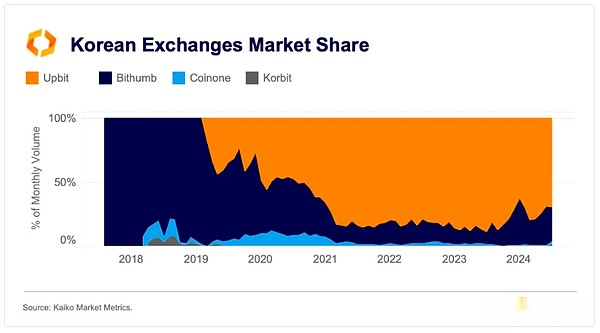
-
Coinone:Coinone’s market share is 1.1%, which is the first exchange in South Korea to launch Ethereum.
-
GOPAX:Binance acquired most of Gopax 72.26% of the equity, which is a strategic measure to enter the Korean market.However, due to regulatory uncertainty, the process still needs to be approved by the government.
-
Korbit:Korbit’s market share is 0.4%, which is the oldest cryptocurrency exchange in South Korea.
project
I) KAIA
Kaia was born in the merger of Klaytn and FINSCHIA. It is a new Layer-1 project led by Korean technology giant Kakao (Klaytn) and LINE (FINSCHIA) under Naver.The merger aims to integrate their respective blockchain platforms into a unified system. The system is named after Greek “and”, symbolizing the connection.The project is planned to be launched at the end of this year and will become the main Layer-1 blockchain in South Korea.The merger is also one of the few M & A cases in the encryption industry so far, and it is worthy of attention.
II) DELABS
South Korea has always been the leader in the field of web2 games, and large companies such as Nexon, Netmarble, NCSOFT, and KRAFTON dominate the global market.Therefore, there are naturally many ongoing attempts in the field of P2E (Play-TO-EARN). People in these major game studios, and even the entire studio, have entered the web3 field, such as WEMADE and NEXON.The Korean game studio DELABS Games is a subsidiary of 4:33 Games and is part of this trend.Delabs Games was founded by former NEXON head Joon Mo Kwon and is emerging in the field of Web3.
Summarize
The cryptocurrency market in South Korea shows complex retail investment and regulatory challenges.Although the country has a large number of proficient technology, the lack of important local blockchain projects highlights the continuous supervision and public cognitive impairment.The upcoming implementation of the “Virtual Asset User Protection Law” marks one step towards solving these problems, aiming to improve market integrity and provide clearer operating guidelines.However, in order to truly use its technical strength and market enthusiasm, South Korea needs to create an environment that is conducive to innovation of blockchain, overcome negative public emotions, and ensure a balanced regulatory framework, encourage long -term investment in Web3 companies, realize the realizationSustainable growth.This balance method is crucial for South Korea to establish a global leader in the development of an encryption.


